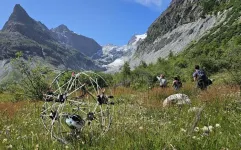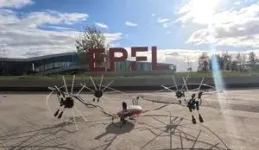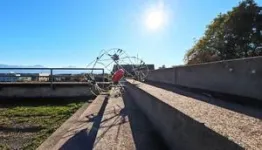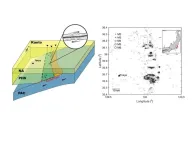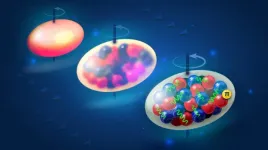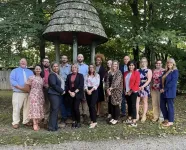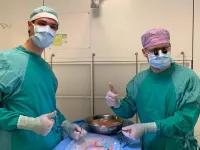(Press-News.org) From mountain goats that run up near-vertical rock faces to armadillos that roll into a protective ball, animals have evolved to adapt effortlessly to changes in their environment. In contrast, when an autonomous robot is programmed to reach a goal, each variation in its pre-determined path presents a significant physical and computational challenge.
Researchers led by Josie Hughes in the CREATE Lab in EPFL’s School of Engineering wanted to develop a robot that could traverse diverse environments as adeptly as animals by changing form on the fly. With GOAT (Good Over All Terrains) they have achieved just that – and created a new paradigm for robotic locomotion and control in the process.
Thanks to its flexible yet durable design, GOAT can spontaneously morph between a flat ‘rover’ shape and a sphere as it moves. This allows it to switch between driving, rolling, and even swimming, all while consuming less energy than a robot with limbs or appendages.
“While most robots compute the shortest path from A to B, GOAT considers the travel modality as well as the path to be taken,” Hughes explains. “For example, instead of going around an obstacle like a stream, GOAT can swim straight through. If its path is hilly, it can passively roll downhill as a sphere to save both time and energy, and then actively drive as a rover when rolling is no longer beneficial.”
The research has been published in Science Robotics.
Compliance is key
To design their robot, the CREATE team took inspiration from across the animal kingdom, including spiders, kangaroos, cockroaches, and octopuses.The team’s bioinspired approach led to a design that is highly compliant, meaning it adapts in response to interaction with its environment, rather than remaining rigid. This compliance means that GOAT can actively alter its shape to change its passive properties, which range from more flexible in its ‘rover’ configuration, to more robust as a sphere.
Built from inexpensive materials, the robot’s simple frame is made of two intersecting elastic fiberglass rods, with four motorized rimless wheels. Two winch-driven cables change the frame’s configuration, ultimately shortening like tendons to draw it tightly into a ball. The battery, onboard computer, and sensors are contained in a payload weighing up to 2 kg that is suspended in the center of the frame, where it is well protected in sphere mode – much as a hedgehog protects its underbelly.
The path of least resistance
CREATE Lab PhD student Max Polzin explains that compliance also allows GOAT to navigate with minimal sensing equipment. With only a satellite navigation system and a device for measuring the robot’s own orientation (inertial measurement unit), GOAT carries no cameras onboard: it simply does not need to know exactly what lies in its path.
“Most robots that navigate extreme terrain have lots of sensors to determine the state of each motor, but thanks to its ability to leverage its own compliance, GOAT doesn’t need complex sensing. It can leverage the environment, even with very limited knowledge of it, to find the best path: the path of least resistance,” Polzin says.
Future research avenues include improved algorithms to help exploit the unique capabilities of morphing, compliant robots, as well as scaling GOAT’s design up and down to accommodate different payloads. Looking ahead, the researchers see many potential applications for their device, from environmental monitoring to disaster response, and even extraterrestrial exploration.
“Robots like GOAT could be deployed quickly into uncharted terrain with minimal perception and planning systems, allowing them to turn environmental challenges into computational assets,” Hughes says. “By harnessing a combination of active reconfiguration and passive adaptation, the next generation of compliant robots might even surpass nature’s versatility.”
END
Morphing robot turns challenging terrain to its advantage
A bioinspired robot developed at EPFL can change shape to alter its own physical properties in response to its environment, resulting in a robust and efficient autonomous vehicle as well as a fresh approach to robotic locomotion.
2025-02-26
ELSE PRESS RELEASES FROM THIS DATE:
New study reveals how rogue planetary-mass objects form in young star clusters
2025-02-26
A groundbreaking study published in Science Advances sheds new light on the mysterious origins of free-floating planetary-mass objects (PMOs)—celestial bodies with masses between stars and planets.
Led by Dr. DENG Hongping of the Shanghai Astronomical Observatory of the Chinese Academy of Sciences, an international team of astronomers used advanced simulations to uncover a novel formation process for these enigmatic objects. The research suggests that PMOs can form directly through violent interactions between circumstellar disks in young star clusters.
The Mystery of Rogue Planetary-Mass ...
School of rock: Properties of rocks in fault zones contribute to earthquake generation
2025-02-26
ANN ARBOR—Earthquakes occur along fault lines between continental plates, where one plate is diving beneath another. Pressure builds between each plate, called fault stress. When this stress builds enough to release, the plates slip and grind against each other, causing an earthquake.
Researchers have long thought that this force is the central driver of earthquakes. But another force is also in the mix: the properties of the rocks in the fault zones along the plate interface. This includes both the structure of the rock as well as how the rocks are arranged along the zones.
Now, a University of Michigan study looking at a small ...
Aston University microbiologist calls for public vigilance and urgent action on the danger of raw sewage in UK seas
2025-02-26
Dr Jonathan Cox writes in Microbiology about the pathogens in raw sewage and the “significant” danger to public health when it ends up in the sea
He contracted a lung infection in 2024, likely from exposure to raw sewage in the sea where he had been swimming
He urges people to check for sewage reports before heading to the beach and calls for investment to improve infrastructure.
Aston University microbiologist Dr Jonathan Cox has written an article for the journal Microbiology on ...
Supercomputing illuminates detailed nuclear structure
2025-02-26
Using the Frontier supercomputer at the Department of Energy’s Oak Ridge National Laboratory, researchers have developed a new technique that predicts nuclear properties in record detail.
The study revealed how the structure of a nucleus relates to the force that holds it together. This understanding could advance efforts in quantum physics and across a variety of sectors, from to energy production to national security.
“Our reliable predictions will bring new insights to the study of nuclear forces and structure,” said Zhonghao Sun of Louisiana State University, formerly of ORNL.
The team’s findings, published in the ...
Ohio tests new model for providing mental health resources to youth in rural communities
2025-02-26
During and after the height of the COVID-19 pandemic, telehealth appointments became a more common part of the American health care system. But even as telehealth options grow, barriers such as long waitlists or a lack of a stable internet connection mean many communities still do not have access to care, particularly for mental health services.
The University of Cincinnati, the Adams County Health Department (ACHD) and other local partners are testing a new collaborative care model that aims to remove these barriers and provide more students access to telemental health care. The team recently received a $1.75 million grant from the Health ...
Breast-conserving surgery improves sexual well-being compared to breast reconstruction
2025-02-26
February 26, 2025 — For women with breast cancer, breast-conserving therapy (BCT) is associated with improved sexual well-being, compared to mastectomy followed by breast reconstruction, reports a study in the March issue of Plastic and Reconstructive Surgery®, the official medical journal of the American Society of Plastic Surgeons (ASPS). The journal is published in the Lippincott portfolio by Wolters Kluwer.
"In our study, patients undergoing BCT scored consistently higher on a measure of sexual well-being, compared to total mastectomy and breast reconstruction," comments Jonas A. Nelson, MD, MPH, of Memorial ...
What can theoretical physics teach us about knitting?
2025-02-26
The practice of purposely looping thread to create intricate knit garments and blankets has existed for millennia. Though its precise origins have been lost to history, artifacts like a pair of wool socks from ancient Egypt suggest it dates back as early as the 3rd to 5th century CE. Yet, for all its long-standing ubiquity, the physics behind knitting remains surprisingly elusive.
“Knitting is one of those weird, seemingly simple but deceptively complex things we take for granted,” says ...
Discovery of rare gene variants provides window into tailored type 2 diabetes treatment
2025-02-26
OKLAHOMA CITY – A new study published in Communications Medicine, a Nature publication, details the discovery of rare gene variants that increase the prevalence of Type 2 diabetes in multiple generations of Asian Indian people. The unusual finding is a step toward more targeted treatment for all people with Type 2 diabetes, a disease with complex genetic influences.
“We wanted to study several generations of Asian Indians because understanding genetics in families can give us better information, and Asian Indians have up to six times higher risk of developing Type 2 diabetes than Europeans. In addition, Asian Indians tend to live clustered together and marry ...
UMCG perfusion technique for donor livers gets worldwide followings
2025-02-26
The perfusion technique developed at UMCG to test the quality of donor livers led to a record number of liver transplants last year. Not only in Groningen, but throughout the Netherlands. Meanwhile, there is worldwide interest in this perfusion technique.
Donor livers can only be stored outside the body for a short time, up to 6 to 10 hours. The organ must therefore get to the recipient as quickly as possible. As a result, transplants have always been under great time pressure. The UMCG has had an ‘Organ Preservation & ...
New method developed to dramatically enhance bioelectronic sensors
2025-02-26
In a breakthrough that could transform bioelectronic sensing, an interdisciplinary team of researchers at Rice University has developed a new method to dramatically enhance the sensitivity of enzymatic and microbial fuel cells using organic electrochemical transistors (OECTs). The research was recently published in the journal Device.
The innovative approach amplifies electrical signals by three orders of magnitude and improves signal-to-noise ratios, potentially enabling the next generation of highly sensitive, low-power biosensors for health and environmental monitoring.
“We have demonstrated a simple yet powerful technique to amplify weak bioelectronic signals ...
LAST 30 PRESS RELEASES:
Bluey’s dad offered professorial chair in archaeology at Griffith University
Beyond small data limitations: Transfer learning-enabled framework for predicting mechanical properties of aluminum matrix composites
Unveiling non-thermal catalytic origin of direct current-promoted catalysis for energy-efficient transformation of greenhouse gases to valuable chemicals
Chronic breathlessness emerging as a hidden strain on hospitals
Paleontologists find first fossil bee nests made inside fossil bones
These fossils were the perfect home for ancient baby bees
Not everyone reads the room the same. A new study examines why.
New research identifies linked energy, immune and vascular changes in ME/CFS
Concurrent frailty + depression likely boost dementia risk in older people
Living in substandard housing linked to kids’ missed schooling and poor grades
Little awareness of medical + psychological complexities of steroid cream withdrawal
Eight in 10 trusts caring for emergency department patients in corridors, finds BMJ investigation
NASA’s Webb telescope finds bizarre atmosphere on a lemon-shaped exoplanet
The gut bacteria that put the brakes on weight gain in mice
Exploring how patients feel about AI transcription
Category ‘6’ tropical cyclone hot spots are growing
Video: Drivers struggle to multitask when using dashboard touch screens, study finds
SLU research shows surge in alcohol-related liver disease driving ‘deaths of despair’
Rising heat reshapes how microbes break down microplastics, new review finds
Roots reveal a hidden carbon pathway in maize plants
Membrane magic: FAMU-FSU researchers repurpose fuel cells membranes for new applications
UN Member States pledge to increase access to diagnosis and inhaled medicines for the 480 million people living with COPD
Combination therapy shows potential to treat pediatric brain cancer ATRT
Study links seabird nesting to shark turf wars in Hawai‘i
Legal sports betting linked to sharp increases in violent crime, study finds
Breakthrough AI from NYUAD speeds up discovery of life-supporting microbes
New Eva Mayr-Stihl Foundation funding initiative boosts research at University of Freiburg on adaptation of forests to global change
The perfect plastic? Plant-based, fully saltwater degradable, zero microplastics
Bias in data may be blocking AI’s potential to combat antibiotic resistance
Article-level metrics would provide more recognition to most researchers than journal-level metrics
[Press-News.org] Morphing robot turns challenging terrain to its advantageA bioinspired robot developed at EPFL can change shape to alter its own physical properties in response to its environment, resulting in a robust and efficient autonomous vehicle as well as a fresh approach to robotic locomotion.
